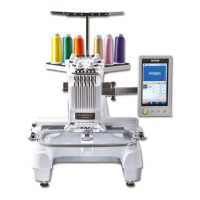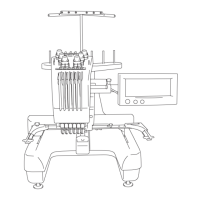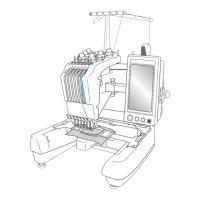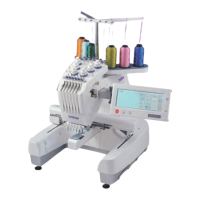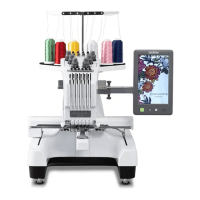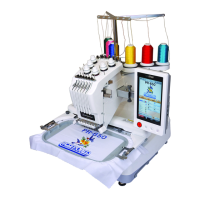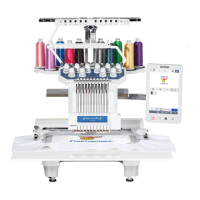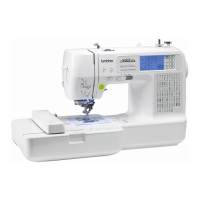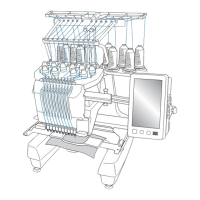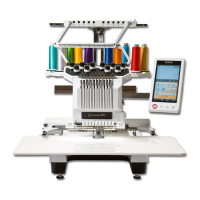Do you have a question about the Brother PR670E and is the answer not in the manual?
Essential precautions for safe sewing operations, covering needle and moving parts.
Guidelines for machine care and storage to ensure longevity and proper function.
Explanation of the six-needle mechanism and automatic color selection for embroidery.
Highlights key operational advantages compared to single-needle embroidery machines.
Advanced feature for managing thread colors and sequences for professional embroidery.
Capabilities for modifying and arranging embroidery patterns, including text.
Essential preliminary steps and information before operating the embroidery machine.
Methods for efficiently finding specific information within the manual.
Identification and explanation of the machine's various components and their roles.
List and description of included items necessary for machine setup and operation.
Information on additional items available for purchase to enhance machine functionality.
Step-by-step instructions for properly installing and preparing the embroidery machine.
Critical safety and operational guidelines to ensure correct and safe use of the machine.
Guidelines for selecting and using appropriate needles to prevent damage or injury.
Important considerations for using bobbins to ensure correct stitching and machine function.
Guide on choosing and loading embroidery patterns from various sources.
Instructions on modifying selected embroidery patterns for customization.
Detailed steps for correctly securing fabric in the embroidery frame for optimal results.
Procedures for securely mounting the embroidery frame onto the machine.
Guide on configuring various settings for the embroidery process.
Step-by-step guide to starting and executing the embroidery process.
Procedures for safely detaching the frame and removing the fabric after embroidery.
Instructions for safely powering down the embroidery machine after use.
Explanation of the meaning and function of various on-screen keys and icons.
Instructions for safely replacing the needle to maintain sewing quality.
Guidance on selecting and utilizing the appropriate embroidery frames for different projects.
Detailed list of available frame types and their recommended uses.
Method for applying stabilizer to fabric to prevent distortion and ensure clean embroidery.
Information on how the machine manages frame positioning for accurate embroidery.
How to manually adjust the pattern's position within the embroidery area.
Procedure for adjusting the pattern's angle to fit fabric orientation or design needs.
How the machine automatically assigns thread colors to needle bars based on pattern sequence.
Steps to take when the upper thread snaps, including re-threading and navigating stitches.
Guide to adjusting bobbin thread tension using weights and the tension-adjusting screw.
How to add basting stitches to secure fabric and prevent misalignment.
Step-by-step process for creating appliqué designs using built-in patterns.
Feature for manually assigning thread colors to needle bars for efficient color changes.
Function to skip specific colors or regions within a pattern without editing.
Setting up automatic lock stitches for pattern start, color change, and thread trim.
Configuring start and end points for patterns, including diagonal repetition.
Adjusting the machine's sewing speed for different frames and fabrics.
Configuring the machine to pause before the next color change.
Ability to substitute threads or needle bars mid-embroidery for efficiency.
Manually assigning thread colors and sewing speeds to specific needle bars.
How to save and retrieve embroidery patterns stored in the machine's memory.
Process for choosing patterns from built-in options, USB, or computer.
Instructions for storing customized or frequently used patterns directly on the machine.
Instructions for transferring patterns to external storage media.
Guide on transferring patterns from the machine to a computer via USB connection.
Steps to access and load patterns previously saved onto the machine.
Process for loading embroidery patterns from USB media or SD cards.
Steps to load embroidery patterns stored on a computer via USB connection.
Detailed guide on modifying pattern size, rotation, and arrangement.
Steps for combining and editing multiple patterns, including text and floral designs.
Accessing and adjusting various machine settings via the settings key.
Customizing on-screen guides like centerpoint markers and grid lines.
Displaying thread names, numbers, or time based on machine or software settings.
Setting machine behavior for cutting jumpstitches, especially with Tajima (.dst) files.
Function to automatically remove stitches shorter than a specified length to prevent breakage.
Power-saving modes that put the machine into sleep or turn it off after inactivity.
Options for setting screen saver display time and customizing the image.
Accessing built-in guides and tutorial videos for machine operation.
Accessing video guides for learning machine operations and features.
Instructions for playing video files stored on USB media or the machine.
Step-by-step guide for creating appliqué designs using specific built-in patterns.
Instructions for sewing large patterns divided into multiple sections.
Practical advice and techniques for optimizing machine operation.
Proper storage and handling of embroidery threads to maintain quality.
Explanation of stabilizer types and their use in embroidery.
Methods for properly hooping fabric to ensure accurate design placement.
A guide matching fabrics with appropriate stabilizers for successful embroidery.
Instructions for setting up and using the optional bobbin winding accessory.
Step-by-step guide for winding thread onto a bobbin using the optional winder.
Routine procedures for cleaning and oiling the machine to ensure optimal performance.
Guide to identifying and resolving common machine problems and error messages.
Explanations of error messages and steps to resolve them.
Steps to adjust the touch panel calibration when keys are unresponsive or misaligned.
Technical details including weight, dimensions, speed, and components.
Instructions for downloading and installing software updates via USB media.
Essential precautions for safe sewing operations, covering needle and moving parts.
Guidelines for machine care and storage to ensure longevity and proper function.
Explanation of the six-needle mechanism and automatic color selection for embroidery.
Highlights key operational advantages compared to single-needle embroidery machines.
Advanced feature for managing thread colors and sequences for professional embroidery.
Capabilities for modifying and arranging embroidery patterns, including text.
Essential preliminary steps and information before operating the embroidery machine.
Methods for efficiently finding specific information within the manual.
Identification and explanation of the machine's various components and their roles.
List and description of included items necessary for machine setup and operation.
Information on additional items available for purchase to enhance machine functionality.
Step-by-step instructions for properly installing and preparing the embroidery machine.
Critical safety and operational guidelines to ensure correct and safe use of the machine.
Guidelines for selecting and using appropriate needles to prevent damage or injury.
Important considerations for using bobbins to ensure correct stitching and machine function.
Guide on choosing and loading embroidery patterns from various sources.
Instructions on modifying selected embroidery patterns for customization.
Detailed steps for correctly securing fabric in the embroidery frame for optimal results.
Procedures for securely mounting the embroidery frame onto the machine.
Guide on configuring various settings for the embroidery process.
Step-by-step guide to starting and executing the embroidery process.
Procedures for safely detaching the frame and removing the fabric after embroidery.
Instructions for safely powering down the embroidery machine after use.
Explanation of the meaning and function of various on-screen keys and icons.
Instructions for safely replacing the needle to maintain sewing quality.
Guidance on selecting and utilizing the appropriate embroidery frames for different projects.
Detailed list of available frame types and their recommended uses.
Method for applying stabilizer to fabric to prevent distortion and ensure clean embroidery.
Information on how the machine manages frame positioning for accurate embroidery.
How to manually adjust the pattern's position within the embroidery area.
Procedure for adjusting the pattern's angle to fit fabric orientation or design needs.
How the machine automatically assigns thread colors to needle bars based on pattern sequence.
Steps to take when the upper thread snaps, including re-threading and navigating stitches.
Guide to adjusting bobbin thread tension using weights and the tension-adjusting screw.
How to add basting stitches to secure fabric and prevent misalignment.
Step-by-step process for creating appliqué designs using built-in patterns.
Feature for manually assigning thread colors to needle bars for efficient color changes.
Function to skip specific colors or regions within a pattern without editing.
Setting up automatic lock stitches for pattern start, color change, and thread trim.
Configuring start and end points for patterns, including diagonal repetition.
Adjusting the machine's sewing speed for different frames and fabrics.
Configuring the machine to pause before the next color change.
Ability to substitute threads or needle bars mid-embroidery for efficiency.
Manually assigning thread colors and sewing speeds to specific needle bars.
How to save and retrieve embroidery patterns stored in the machine's memory.
Process for choosing patterns from built-in options, USB, or computer.
Instructions for storing customized or frequently used patterns directly on the machine.
Instructions for transferring patterns to external storage media.
Guide on transferring patterns from the machine to a computer via USB connection.
Steps to access and load patterns previously saved onto the machine.
Process for loading embroidery patterns from USB media or SD cards.
Steps to load embroidery patterns stored on a computer via USB connection.
Detailed guide on modifying pattern size, rotation, and arrangement.
Steps for combining and editing multiple patterns, including text and floral designs.
Accessing and adjusting various machine settings via the settings key.
Customizing on-screen guides like centerpoint markers and grid lines.
Displaying thread names, numbers, or time based on machine or software settings.
Setting machine behavior for cutting jumpstitches, especially with Tajima (.dst) files.
Function to automatically remove stitches shorter than a specified length to prevent breakage.
Power-saving modes that put the machine into sleep or turn it off after inactivity.
Options for setting screen saver display time and customizing the image.
Accessing built-in guides and tutorial videos for machine operation.
Accessing video guides for learning machine operations and features.
Instructions for playing video files stored on USB media or the machine.
Step-by-step guide for creating appliqué designs using specific built-in patterns.
Instructions for sewing large patterns divided into multiple sections.
Practical advice and techniques for optimizing machine operation.
Proper storage and handling of embroidery threads to maintain quality.
Explanation of stabilizer types and their use in embroidery.
Methods for properly hooping fabric to ensure accurate design placement.
A guide matching fabrics with appropriate stabilizers for successful embroidery.
Instructions for setting up and using the optional bobbin winding accessory.
Step-by-step guide for winding thread onto a bobbin using the optional winder.
Routine procedures for cleaning and oiling the machine to ensure optimal performance.
Guide to identifying and resolving common machine problems and error messages.
Explanations of error messages and steps to resolve them.
Steps to adjust the touch panel calibration when keys are unresponsive or misaligned.
Technical details including weight, dimensions, speed, and components.
Instructions for downloading and installing software updates via USB media.
| Needle Count | 6 |
|---|---|
| USB Port | Yes |
| LCD Display | Yes |
| Type | Embroidery Machine |
| Automatic Needle Threader | Yes |
| Automatic Thread Trimmer | Yes |
| Connectivity | USB |
| Built-in Memory | Yes |
| Warranty | 25-year limited warranty |
| Maximum Embroidery Speed | 1000 stitches per minute |
